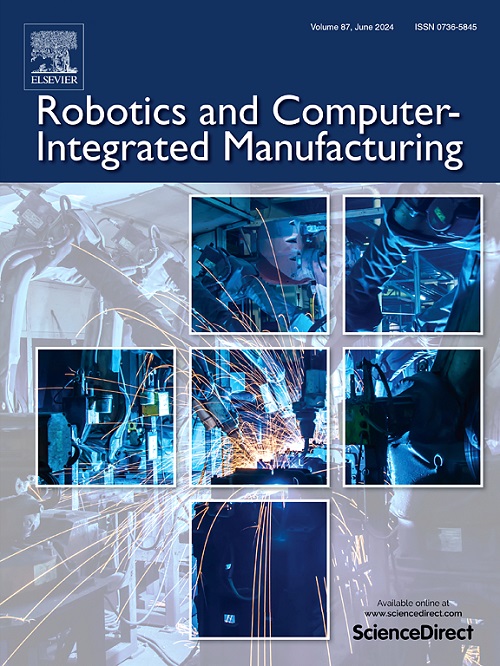面向工业人机交互的安全运动规划:基于数字孪生和混合现实的协同进化方法
IF 9.1
1区 计算机科学
Q1 COMPUTER SCIENCE, INTERDISCIPLINARY APPLICATIONS
引用次数: 0
摘要
先进的人机交互(HRI)对于“工业5.0”等下一代以人为中心的制造模式至关重要。尽管最近的相互认知方法可以增强人与机器人之间的理解和协作,但这些方法通常依赖于预定义的规则,并且在适应新任务或工作环境的变化方面受到限制。这些限制可能会阻碍协作机器人在动态制造环境中的普及,在动态制造环境中,任务可能高度可变,并且经常发生不可预见的操作更改。为了解决这些挑战,我们提出了一种用于工业人机交互安全运动规划的协同进化方法。其核心思想是利用人类数字孪生体(HDT)和混合现实(MR)技术,在统一和连续的框架内促进人类工人安全操作认知的演变和机器人安全运动规划策略的演变。具体来说,HDT捕捉人类的实时行为和姿势,使机器人能够动态地适应人类行为和环境的变化。HDT还改进了基于深度强化学习(DRL)的运动规划,使机器人能够不断地从人类的行为中学习并更新它们的运动策略。另一方面,MR叠加了物理世界中关于任务和机器人的丰富信息,帮助人类工作者更好地理解和适应机器人的行为。MR还提供了直观的基于手势的用户界面,进一步提高了人机交互的流畅性。我们通过对现实制造场景的评估验证了所提出方法的有效性,展示了其在智能制造背景下推进人力资源调研实践的潜力。本文章由计算机程序翻译,如有差异,请以英文原文为准。
Towards safe motion planning for industrial human-robot interaction: A co-evolution approach based on human digital twin and mixed reality
Advanced human-robot interaction (HRI) is essential for the next-generation human-centric manufacturing mode such as “Industry 5.0”. Despite recent mutual cognitive approaches can enhance the understanding and collaboration between humans and robots, these methods often rely on predefined rules and are limited in adapting to new tasks or changes of the working environment. These limitations can hinder the popularization of collaborative robots in dynamic manufacturing environments, where tasks can be highly variable, and unforeseen operational changes frequently occur. To address these challenges, we propose a co-evolution approach for the safe motion planning of industrial human-robot interaction. The core idea is to promote the evolution of human worker’s safe operation cognition as well as the evolution of robot’s safe motion planning strategy in a unified and continuous framework by leveraging human digital twin (HDT) and mixed reality (MR) technologies. Specifically, HDT captures real-time human behaviors and postures, which enables robots to adapt dynamically to the changes of human behavior and environment. HDT also refines deep reinforcement learning (DRL)-based motion planning, allowing robots to continuously learn from human actions and update their motion strategies. On the other hand, MR superimposes rich information regarding the tasks and robot in the physical world, helping human workers better understand and adapt to robot’s actions. MR also provides intuitive gesture-based user interface, further improving the smoothness of human-robot interaction. We validate the proposed approach’s effectiveness with evaluations in realistic manufacturing scenarios, demonstrating its potential to advance HRI practice in the context of smart manufacturing.
求助全文
通过发布文献求助,成功后即可免费获取论文全文。
去求助
来源期刊
CiteScore
24.10
自引率
13.50%
发文量
160
审稿时长
50 days
期刊介绍:
The journal, Robotics and Computer-Integrated Manufacturing, focuses on sharing research applications that contribute to the development of new or enhanced robotics, manufacturing technologies, and innovative manufacturing strategies that are relevant to industry. Papers that combine theory and experimental validation are preferred, while review papers on current robotics and manufacturing issues are also considered. However, papers on traditional machining processes, modeling and simulation, supply chain management, and resource optimization are generally not within the scope of the journal, as there are more appropriate journals for these topics. Similarly, papers that are overly theoretical or mathematical will be directed to other suitable journals. The journal welcomes original papers in areas such as industrial robotics, human-robot collaboration in manufacturing, cloud-based manufacturing, cyber-physical production systems, big data analytics in manufacturing, smart mechatronics, machine learning, adaptive and sustainable manufacturing, and other fields involving unique manufacturing technologies.

 求助内容:
求助内容: 应助结果提醒方式:
应助结果提醒方式:


